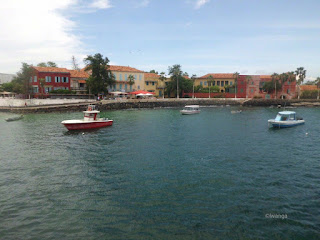Luapula is one of three provinces that make up northern Zambia. Sometimes collectively referred to as the Northern [Tourism] Circuit, Luapula, Muchinga and Northern provinces have a concentration of tourist attractions. Luapula has, among other attractions, lakes, white sand beaches, a number of waterfalls, a hotspring, national parks and wetlands that are rich in wildlife and birdlife (indigenous and migrants) including the Black Lechwe (can be seen in their thousands at a time) and the rare Shoebill Stork. It also has a wealth of history and culture, including traditional ceremonies, prominent among them the Umutomboko held annually at Mwansabombwe.
Fishing is one of the main (seasonal) activities on Lake Bangweulu and an economic mainstay for many households. Some of the best known species are the bream, yellow belly, catfish and tiger fish. Both tourists and locals frequent the lake and beach for a variety of activities. Samfya.
Boat ride on Lake Bangweulu, heading from the beach to the harbour. Samfya has lovely white sand beaches and a number of waterfront lodges. It is advisable to carry sunscreen and mosquito repellent.
The Post Boat, also known locally as ichombo, is an old and popular form of transport on Lake Bangweulu. Samfya harbour.
Ntumbacushi is on the Ngona river in Kawambwa about 250 km from Samfya. Ntumbacushi means 'smoke mountain' and at a distance, the mist looks like smoke pouring out of a mountain top. You can go as close as you like but must contend with the wind and slippery ground. You can camp here, hike, braai or bring a picnic basket on a day trip. Like other national heritage sites, it has an entry fee.
Another viewing point of Ntumbacushi falls across the bridge. You must be prepared to get drenched (falls, river and rain depending on the season you visit) as you get this close-up view. We were so cold after this and had to stand by the local shop's braai but there was barely any fire. Next time I will be sure to pack a change of clothes.
Samfya harbour before returning to the beach
Further up on this route, about 310 km from Samfya and 60 km from Kawambwa 'CBD', is the Lumangwe falls at the border of Kawambwa and Mporokoso. It looks like a smaller version of the Victoria falls but has, in my opinion, a more striking presence probably because of how close you can get and the suddenness of the sight in what seems like the middle of nowehere.
Lumangwe is within 5 km of Kabwelume falls (one entry fee for both) and sits in a lush mini rain forest. There are budget lodging facilities and you can also camp here. The road is currently bad but the destination is definitely worth the drive. You can see the video here http://eyesajar.blogspot.com/2016/07/water-spectacularzambia.html
Sunset at Lumangwe
Lumangwe falls
Footprints in the sand. Samfya beach.
*I will keep updating this post as I see more of Luapula. You can see more pictures and videos from around Zambia here http://eyesajar.blogspot.com/2016/07/water-spectacularzambia.html #SpectacularZambia


























